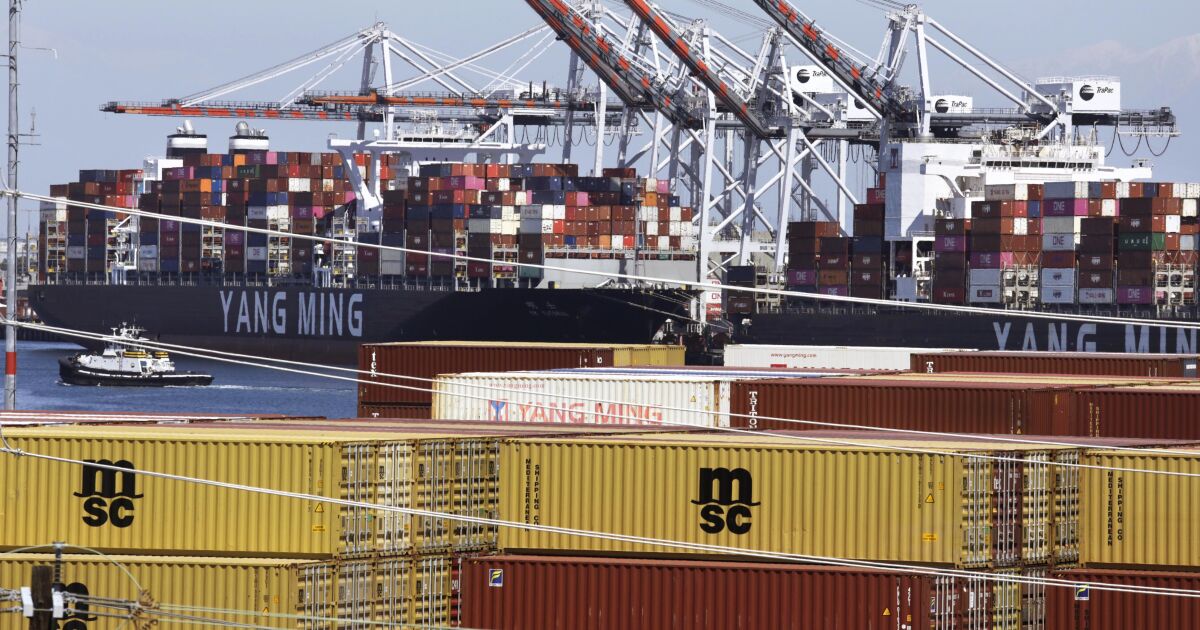Business
West Coast dockworkers, employers reach tentative contract agreement

West Coast dockworkers have reached a tentative deal with employers, the two sides announced Wednesday, potentially ending months of port labor strife that could have threatened the nation’s economic outlook.
In a joint statement, the International Longshore and Warehouse Union and the Pacific Maritime Assn., which represents shipping lines and terminal operators, said the new six-year deal covers workers at all 29 West Coast ports but did not release further details. The agreement is pending ratification by the union and employers.
The previous contract covering 22,000 workers expired on June 30. Union members have been working without a contract since then. Negotiations snagged over wages and benefits after reaching an agreement over automation.
As the high-stakes talks continued, ports at Los Angeles, Long Beach and other West Coast harbors experienced delays and intermittent disruptions because of worker shortages that the employers said were intentional labor actions by the union. Anxiety rippled through retailers, manufacturers and other importers, who called on the White House to intervene.
The Los Angeles and Long Beach ports, which combined handle nearly 40% of U.S. imports from Asia, lost business as some shippers sent cargo through East and Gulf coast ports.
“We are pleased to have reached an agreement that recognizes the heroic efforts and personal sacrifices of the ILWU workforce in keeping our ports operating,” PMA President James McKenna and ILWU President Willie Adams said in the release. “We are also pleased to turn our full attention back to the operation of the West Coast Ports.
The tentative agreement “brings the stability and confidence that customers have been seeking,” said Gene Seroka, executive director of the Port of Los Angeles, the nation’s largest cargo container port. “We look forward to collaborating with our partners in a renewed effort to bring back cargo and demonstrate why Los Angeles is the first choice for Trans-Pacific trade.”
International labor economist Jock O’Connell of Beacon Economics called the proposed deal “a very positive sign for the West Coast ports and for everyone who sends their cargo through them.”
“The reputation of the West Coast ports as reliable conduits for Asian trade will be less tarnished, but they still have a long way to go in assuring shippers and customers, the importers and exporters,” in the wake of recent disruptions that caused significant delays in the movement of goods, he said. O’Connell said the ratification process could take several weeks, adding: “It’s important to emphasize that this is not finished.”
Acting U.S. Secretary of Labor Julie Su, who met with both sides in recent days, said the agreement demonstrated “once again that collective bargaining — though sometimes difficult — works.”
“Thanks to the hard work and perseverance of the leadership of the ILWU and the PMA, the tentative agreement delivers important stability for workers, for employers and for our country’s supply chain,” Su said in a news release.
The PMA said Su played a “key role” in the negotiations.
President Biden hailed Su’s role in ending “a long and sometimes acrimonious negotiation” and congratulated port workers “who will finally get the pay, benefits and quality of life they deserve.”
Mayor Karen Bass said the agreement was “a win for the working people of our City,” noting that the Los Angeles port generates economic activity that supports 1 in 15 jobs in L.A.

Business
Edison’s safety record declined last year. Executive bonuses rose anyway

The state law that shielded Southern California Edison and other utilities from liability for wildfires sparked by their equipment came with a catch: Top utility executives would be forced to take a pay cut if their company’s safety record declined.
Edison’s safety record did decline last year. The number of fires sparked by its equipment soared to 178, from 90 the year before and 39% above the five-year average.
Serious injuries suffered by employees jumped by 56% over the average. Five contractors working on its electric system died.
As a result of that performance, the utility’s parent company, Edison International, cut executive bonuses awarded for the 2024 year, it told California regulators in an April 1 report.
For Edison International employees, planned executive cash bonuses were cut by 5%, and executives at Southern California Edison saw their bonuses shrink by 3%, said Sergey Trakhtenberg, a compensation specialist for the company.
But cash bonuses for four of Edison’s top five executives actually rose last year, by as much as 17%, according to a separate March report by Edison to federal regulators. Their long-term bonuses of stock and options, which are far more valuable and not tied to safety, also rose.
Of the top five executives, only Pedro Pizarro, chief executive of Edison International, saw his cash bonus decline. He received a cash bonus of 128% of his salary rather than the planned 135% because of the safety failures, the company said, for total compensation including salary of $13.8 million.
The cash bonuses increased for the other top four executives despite the safety-related deductions because of how they performed on other responsibilities, said Trakhtenberg, Edison’s director of total rewards. He said bonuses would have been higher were it not for safety-related reductions.
“Compensation is structured to promote safety,” Trakhtenberg said, calling it “the main focus of the company.”
Consumer advocates say the fact that bonuses increased in spite of the decline in safety highlights a flaw in AB 1054, the 2019 law that reduced the liability of for-profit utility companies like Edison for damaging wildfires ignited by their equipment.
AB 1054 created a wildfire fund to pay for fire damages in an effort to ensure that utilities wouldn’t be rendered insolvent by having to bear billions of dollars in damage costs.
In return, the legislation said executive bonus plans for utilities should be “structured to promote safety as a priority and to ensure public safety and utility financial stability.”
“All these supposed accountability measures that were put into the bill are turning out to be toothless,” said Mark Toney, executive director of The Utility Reform Network, a consumer advocacy group in San Francisco.
“If executives aren’t feeling a significant reduction in salary when there is a significant increase in wildfire safety incidents,” Toney said, “then the incentive is gone.”
One of the executives who received an increased cash bonus was Adam Umanoff, Edison’s general counsel.
Umanoff was expected to get 85% of his $706,000 salary, or $600,000, as a cash bonus as his target at the year’s beginning. The deduction for safety failures reduced that bonus, Trakhtenberg said. But Umanoff’s performance on other goals “was significantly above target” and thus increased his cash bonus to 101% of his salary.
So despite the safety failures, Umanoff received a cash bonus of $717,000, or 19% higher than he was expected to receive.
“If you can just make it up somewhere else,” Toney said, “the incentive is gone.”
The utility recently told its investors that AB 1054 will protect it from potential liabilities of billions of dollars if its equipment is found to have sparked the Eaton fire on Jan. 7, resulting in 18 deaths and the destruction of thousands of homes and commercial buildings.
The cause of the blaze, which videos captured igniting under one of Edison’s transmission towers, is still under investigation. Pizarro has said the reenergization of an idle transmission line is now a leading theory of what sparked the deadly fire.
The 2019 legislation was passed in a matter of weeks to bolster the financial health of the state’s for-profit electric companies after the Camp fire in Butte County, which was caused by a Pacific Gas & Electric transmission line.
The wildfire destroyed the town of Paradise and killed 85 people, and the damages helped push PG&E into bankruptcy.
At the bill-signing ceremony, Gov. Gavin Newsom touted its language that said utilities could not access the money in a new state wildfire fund and cap their liabilities from a blaze caused by their equipment unless they tied executive compensation to their safety performance.
In April, Edison filed its mandatory annual safety performance metrics report with the Public Utilities Commission as it seeks approval to raise customer electric rates by more than 10% this year.
In the report, Edison said that because its safety record worsened in 2024 on certain key metrics, its executives took “a total deduction of 18 points” on a 100-point scale used in determining bonuses.
“Safety and compliance are foundational to SCE, and events such as employee fatalities or serious injuries to the public can result in meaningful deduction or full elimination” of executive incentive compensation, the company wrote.
Edison didn’t explain in the report what an 18-point deduction meant to executives in actual dollar terms, another point of frustration with consumer advocates trying to determine if executive compensation plans genuinely comply with AB 1054.
“Without seeing dollar figures, it is impossible to ascertain whether a utility’s incentive compensation plan is reasonable,” the Public Advocates Office at the state Public Utilities Commission wrote in a 2022 letter to wildfire safety regulators.
To try to determine how much the missed safety goals actually impacted the compensation of Edison executives last year, The Times looked at a separate federal securities report Edison filed for investors known as the proxy statement.
In that March report, Edison detailed how the majority of its compensation to executives is based on its profit and stock price appreciation, and not safety.
Safety helps determine about 50% of the cash bonuses paid to executives each year, the report said. But more valuable are the long-term incentive bonuses, which are paid in shares of stock and stock options and are based on earnings.
The Utility Reform Network, which is also known as TURN, pointed to those stock bonuses in a 2021 letter to regulators where it questioned whether Edison and the state’s other two big for-profit utilities were actually tying executive compensation to safety.
“Good financial performance does not necessarily mean that the utility prioritizes safety,” TURN staff wrote in the letter.
Trakhtenberg disagreed, saying the company’s “long-term incentives are focused on promoting financial stability.” A key part of that is the company’s ability “over the long term to safely deliver reliable, affordable power,” he said.
Trakhtenberg noted that the state Office of Energy Infrastructure Safety had approved the company’s executive compensation plan in October, saying it met the requirements of AB 1054, as well as every year since the agency was established in July 2021.
The Times asked the energy safety office if it audited the utilities’ compensation reports or tried to determine how much money Edison executives lost because of the safety failures.
Sandy Cooney, a spokesman for the agency, said that the office had “no statutory authority … to audit executive compensation structures.” He referred the reporter to Edison for information on how much executive compensation had actually declined in dollar amounts because of the missed safety goals.
A committee of Edison board members determines what goals will be tied to safety, Trakhtenberg said, and whether those goals have been met.
Even though five contractors died last year while working on Edison’s electrical system, the committee didn’t include contractor safety as a goal, according to the company’s documents.
And the committee said the company met its goal in protecting the public even though three people died from its equipment and there was a 27% increase in deaths and serious injuries among the public compared to the five-year average.
Trakhtenberg said most of the serious injuries happened to people committing theft or vandalism, which is why the committee said the goal had been met.
Edison has told regulators that if its equipment starts a catastrophic wildfire, the committee could decide to eliminate executives’ cash bonuses.
But the company’s documents show that it hasn’t eliminated or even reduced bonuses for the 2022 Fairview fire in Riverside County, which killed two people, destroyed 22 homes and burned 28,000 acres.
In 2023, investigators blamed Edison’s equipment for igniting the fire, saying one of its conductors came in contact with a telecommunications cable, creating sparks that fell into vegetation.
Trakhtenberg said the board’s compensation committee reviewed the circumstances of the fire that year and found that the company had acted “prudently” in maintaining its equipment. The committee decided not to reduce executive bonuses for the fire, he said.
In March, the Public Utilities Commission fined Edison $2.2 million for the fire, saying it had violated four safety regulations, including by failing to cooperate with investigators.
Trakhtenberg said the compensation committee would reconsider its decision not to penalize executives for the deadly fire at its next meeting.
TURN has repeatedly asked regulators not to approve Edison’s compensation plans, detailing how its committee has “undue discretion” in setting goals and then determining whether they have been met.
But the energy safety office has approved the plans anyway. Toney said he believes the responsibility for reviewing the compensation plans and utilities’ wildfire safety should be transferred back to the Public Utilities Commission, which had done the work until 2021.
The energy safety office has rules that make the review process less transparent than it is at the commission, he said.
“The whole process, we feel is rigged heavily in favor of utilities,” he said.
Business
Cable giant Charter to buy Cox in a $34.5-billion deal, uniting providers that serve SoCal

Charter Communications and Cox Communications plan to merge in a $34.5-billion deal that would unite Southern California’s two major cable TV and internet providers to sell services under the Spectrum brand.
The proposed consolidation, announced Friday, comes as the industry grapples with accelerating cable customer losses amid the shift to streaming.
The companies could face even more cord-cutting after their long-time programming partner, Walt Disney Co., begins offering its ESPN sports channel directly to fans in a stand-alone streaming service debuting this fall.
If approved by Charter shareholders and regulators, the merger would end one of the longest TV sports blackouts.
Cox customers in Rancho Palos Verdes, Rolling Hills Estates and Orange County would finally have the Dodgers’ TV channel available in their lineups. For more than a decade, Cox has refused to carry SportsNet LA because of its high cost.
Charter distributes the Dodgers channel as part of a $8.35-billion television contract signed with the team’s owners in 2013. Charter has bled hundreds of millions of dollars on that arrangement and now offers the channel more widely via a streaming app.
The Atlanta-based Cox is the nation’s third-largest cable company with more than 6.5 million digital cable, internet, telephone and home security customers. Stamford, Conn.-based Charter has more than 32 million customers.
Charter dramatically expanded its Los Angeles presence in 2016 by acquiring Time Warner Cable for more than $60 billion.
The Charter-Cox combination would have 38 million customer homes in the country — a larger footprint than longtime cable leader, Philadelphia’s Comcast Corp.
“This transformational transaction will create an industry leader in mobile and broadband communication services and seamless video entertainment,” Charter Chief Executive Christopher Winfrey said in a conference call with analysts.
Winfrey would become the proposed entity’s CEO.
A major motivation for the deal was to be able to combine operations in Los Angeles, Orange and San Diego counties where both services currently operate and add attractive markets like Phoenix, Winfrey told analysts.
“Our network will span approximately 46 states passing nearly 70 million homes and businesses,” Winfrey said.
Cox is privately held. The billionaire Cox family, descendants of an Ohio press baron who bought his first newspaper in 1898, began acquiring cable systems in 1962 and has since held them with a tight grip. The Cox cable assets were long seen as a lucrative target.
Last year, Cox generated $13.1 billion in revenue and $5.4 billion in adjusted earnings before interest, taxes, depreciation and amortization.
“Cox was always the first name that would come up in consolidation conversations… and it was always the first name dismissed,” longtime cable analyst Craig Moffett wrote in a Friday research note. “Cox wasn’t for sale.”
Until it was.
In an unexpected twist, the name of the merged company would be changed to Cox within a year of the deal closing. However, its products would carry the Spectrum moniker.
The Cox family would be the largest shareholder, owning about 23% of the combined entity’s outstanding shares.
Charter shares got a slight bump on Friday’s news, climbing nearly 2% to $427.25.
“Cable is a scale business. [The] added size should help Charter compete better with the larger telcos, tech companies and [Elon Musk’s] Starlink,” said Chris Marangi, co-chief investment officer of value at the New York-based Gabelli Funds, a large media investor.
Adding the Cox homes will allow Charter to expand distribution for its El Segundo-based Spectrum News channel.
Charter said it would absorb Cox’s commercial fiber, information technology and cloud businesses. Cox Enterprises agreed to contribute the residential cable business to Charter Holdings.
Cox Enterprises would be paid $4 billion in cash and receive about $6 billion in convertible preferred units, which could eventually be exchanged into Charter shares. The Cox family would get about 33.6 million common units in the Charter Holdings partnership, worth nearly $12 billion.
The combined entity will absorb Cox’s $12 billion in outstanding debt.
Charter’s ability to navigate the challenged landscape was a factor in the family’s decision, said Cox Enterprises Chief Executive Alex Taylor, a great-grandson of the company’s founder, told analysts.
“Charter has really impressed us above all others with the way they have spent capital,” Taylor said. “In the last five years, they’ve spent over $50 billion investing” in internet infrastructure and building a wireless phone service.
“This deal starts with mobile,” cable analyst Moffett wrote. “Cox is relatively late to the wireless game. But that only means that the opportunity in [the combined companies’] footprint is that much larger.”
The companies said they could wring about $500 million a year in annual cost savings.
The combined company would have about $111 billion of debt.
Cox would have two directors on the 13-member board, including Taylor, who would serve as chairman.
Advance/Newhouse would keep its two board members. Advance/Newhouse would hold about 10% of the new company’s shares.
The transaction is expected to close at the same time as Charter’s merger with Liberty Broadband, which was approved by Charter and John Malone’s Liberty Broadband stockholders in February.
After the consolidation, Liberty Broadband will no longer be a direct Charter shareholder.
The Associated Press contributed to this report.
Business
Video: How Staffing Shortages Have Plagued Newark Airport

What’s causing major flight delays and disruptions at Newark Liberty International Airport? Niraj Chokshi, a reporter at The New York Times covering transportation, explains how a staffing shortage has contributed to the chaos and what’s being done to address it.
-

 Austin, TX1 week ago
Austin, TX1 week agoBest Austin Salads – 15 Food Places For Good Greens!
-

 World1 week ago
World1 week agoNew German chancellor aims for stronger EU ties with France and Poland
-

 Technology1 week ago
Technology1 week agoThe best iPad to buy
-
Indiana1 week ago
Star-filled roster for Team Indiana at Saturday’s Prep Ball Stars Midwest Challenge
-

 News1 week ago
News1 week agoJudge Orders Release of Rumeysa Ozturk, Tufts Student Detained by ICE
-

 Lifestyle1 week ago
Lifestyle1 week agoA Guide to Bravo’s New Shows, Including “Wife Swap: The Real Housewives Edition”
-

 Business1 week ago
Business1 week agoA Decade-Long Search for a Battery That Can End the Gasoline Era
-

 News1 week ago
News1 week agoTrump cuts tariffs on U.K. cars, steel and aluminum but keeps 10% base duty













